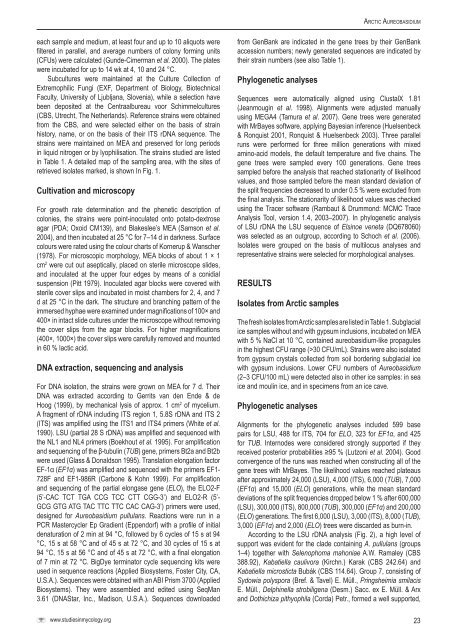Create successful ePaper yourself
Turn your PDF publications into a flip-book with our unique Google optimized e-Paper software.
Ar c t i c Au r e o b a s i d i umeach sample and medium, at least four and up to 10 aliquots werefiltered in parallel, and average numbers of colony forming units(CFUs) were calculated (Gunde-Cimerman et al. 2000). The plateswere incubated for up to 14 wk at 4, 10 and 24 °C.Subcultures were maintained at the Culture Collection ofExtremophilic Fungi (EXF, Department of Biology, BiotechnicalFaculty, University of Ljubljana, Slovenia), while a selection havebeen deposited at the Centraalbureau voor Schimmelcultures(<strong>CBS</strong>, Utrecht, The Netherlands). Reference strains were obtainedfrom the <strong>CBS</strong>, and were selected either on the basis of strainhistory, name, or on the basis of their ITS rDNA sequence. Thestrains were maintained on MEA and preserved for long periodsin liquid nitrogen or by lyophilisation. The strains studied are listedin Table 1. A detailed map of the sampling area, with the sites ofretrieved isolates marked, is shown In Fig. 1.Cultivation and microscopyFor growth rate determination and the phenetic description ofcolonies, the strains were point-inoculated onto potato-dextroseagar (PDA; Oxoid CM139), and Blakeslee’s MEA (Samson et al.2004), and then incubated at 25 °C for 7–14 d in darkness. Surfacecolours were rated using the colour charts of Kornerup & Wanscher(1978). For microscopic morphology, MEA blocks of about 1 × 1cm 2 were cut out aseptically, placed on sterile microscope slides,and inoculated at the upper four edges by means of a conidialsuspension (Pitt 1979). Inoculated agar blocks were covered withsterile cover slips and incubated in moist chambers for 2, 4, and 7d at 25 °C in the dark. The structure and branching pattern of theimmersed hyphae were examined under magnifications of 100× and400× in intact slide cultures under the microscope without removingthe cover slips from the agar blocks. For higher magnifications(400×, 1000×) the cover slips were carefully removed and mountedin 60 % lactic acid.DNA extraction, sequencing and analysisFor DNA isolation, the strains were grown on MEA for 7 d. TheirDNA was extracted according to Gerrits van den Ende & deHoog (1999), by mechanical lysis of approx. 1 cm 2 of mycelium.A fragment of rDNA including ITS region 1, 5.8S rDNA and ITS 2(ITS) was amplified using the ITS1 and ITS4 primers (White et al.1990). LSU (partial 28 S rDNA) was amplified and sequenced withthe NL1 and NL4 primers (Boekhout et al. 1995). For amplificationand sequencing of the β-tubulin (TUB) gene, primers Bt2a and Bt2bwere used (Glass & Donaldson 1995). Translation elongation factorEF-1α (EF1α) was amplified and sequenced with the primers EF1-728F and EF1-986R (Carbone & Kohn 1999). For amplificationand sequencing of the partial elongase gene (ELO), the ELO2-F(5’-CAC TCT TGA CCG TCC CTT CGG-3’) and ELO2-R (5’-GCG GTG ATG TAC TTC TTC CAC CAG-3’) primers were used,designed for Aureobasidium pullulans. Reactions were run in aPCR Mastercycler Ep Gradient (Eppendorf) with a profile of initialdenaturation of 2 min at 94 °C, followed by 6 cycles of 15 s at 94°C, 15 s at 58 °C and of 45 s at 72 °C, and 30 cycles of 15 s at94 °C, 15 s at 56 °C and of 45 s at 72 °C, with a final elongationof 7 min at 72 °C. BigDye terminator cycle sequencing kits wereused in sequence reactions (Applied Biosystems, Foster City, CA,U.S.A.). Sequences were obtained with an ABI Prism 3700 (AppliedBiosystems). They were assembled and edited using SeqMan3.61 (DNAStar, Inc., Madison, U.S.A.). Sequences downloadedwww.studiesinmycology.orgfrom GenBank are indicated in the gene trees by their GenBankaccession numbers; newly generated sequences are indicated bytheir strain numbers (see also Table 1).Phylogenetic analysesSequences were automatically aligned using ClustalX 1.81(Jeanmougin et al. 1998). Alignments were adjusted manuallyusing MEGA4 (Tamura et al. 2007). Gene trees were generatedwith MrBayes software, applying Bayesian inference (Huelsenbeck& Ronquist 2001, Ronquist & Huelsenbeck 2003). Three parallelruns were performed for three million generations with mixedamino-acid models, the default temperature and five chains. Thegene trees were sampled every 100 generations. Gene treessampled before the analysis that reached stationarity of likelihoodvalues, and those sampled before the mean standard deviation ofthe split frequencies decreased to under 0.5 % were excluded fromthe final analysis. The stationarity of likelihood values was checkedusing the Tracer software (Rambaut & Drummond: MCMC TraceAnalysis Tool, version 1.4, 2003–2007). In phylogenetic analysisof LSU rDNA the LSU sequence of Elsinoe veneta (DQ678060)was selected as an outgroup, according to Schoch et al. (2006).Isolates were grouped on the basis of multilocus analyses andrepresentative strains were selected for morphological analyses.RESULTSIsolates from Arctic samplesThe fresh isolates from Arctic samples are listed in Table 1. Subglacialice samples without and with gypsum inclusions, incubated on MEAwith 5 % NaCl at 10 °C, contained aureobasidium-like propagulesin the highest CFU range (>30 CFU/mL). Strains were also isolatedfrom gypsum crystals collected from soil bordering subglacial icewith gypsum inclusions. Lower CFU numbers of Aureobasidium(2–3 CFU/100 mL) were detected also in other ice samples: in seaice and moulin ice, and in specimens from an ice cave.Phylogenetic analysesAlignments for the phylogenetic analyses included 599 basepairs for LSU, 488 for ITS, 704 for ELO, 323 for EF1α, and 425for TUB. Internodes were considered strongly supported if theyreceived posterior probabilities ≥95 % (Lutzoni et al. 2004). Goodconvergence of the runs was reached when constructing all of thegene trees with MrBayes. The likelihood values reached plateausafter approximately 24,000 (LSU), 4,000 (ITS), 6,000 (TUB), 7,000(EF1α) and 15,000 (ELO) generations, while the mean standarddeviations of the split frequencies dropped below 1 % after 600,000(LSU), 300,000 (ITS), 800,000 (TUB), 300,000 (EF1α) and 200,000(ELO) generations. The first 6,000 (LSU), 3,000 (ITS), 8,000 (TUB),3,000 (EF1α) and 2,000 (ELO) trees were discarded as burn-in.According to the LSU rDNA analysis (Fig. 2), a high level ofsupport was evident for the clade containing A. pullulans (groups1–4) together with Selenophoma mahoniae A.W. Ramaley (<strong>CBS</strong>388.92), Kabatiella caulivora (Kirchn.) Karak (<strong>CBS</strong> 242.64) andKabatiella microsticta Bubák (<strong>CBS</strong> 114.64). Group 7, consisting ofSydowia polyspora (Bref. & Tavel) E. Müll., Pringsheimia smilacisE. Müll., Delphinella strobiligena (Desm.) Sacc. ex E. Müll. & Arxand Dothichiza pithyophila (Corda) Petr., formed a well supported,23
















